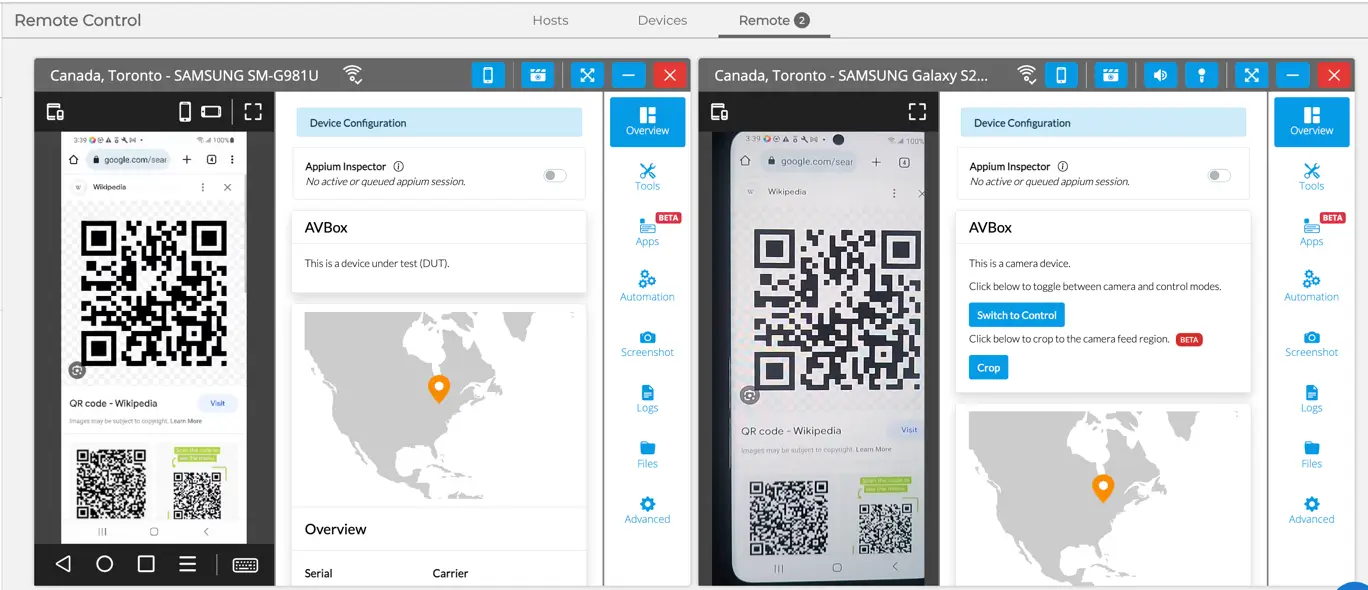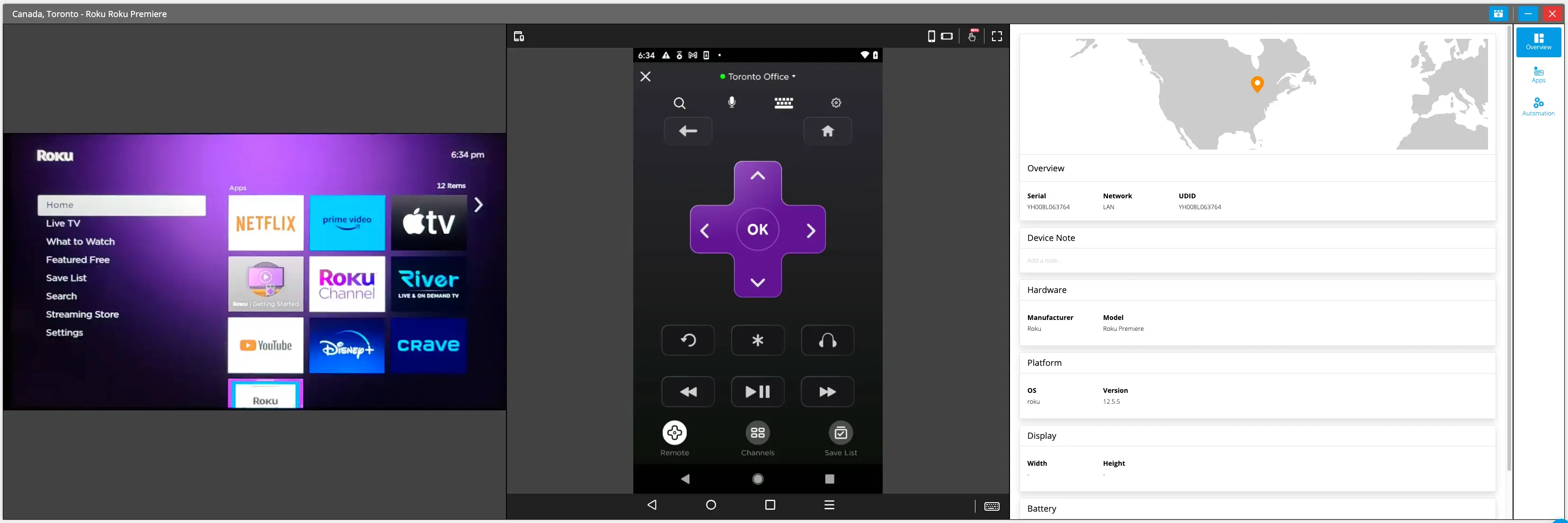A/V Box
Overview
For developers and testers involved in the audio/visual media sphere of technology, testing for a variety of issues specific to A/V apps and hardware is essential. At HeadSpin we want to assist you in your testing goals and ensure you have a high-quality experience with developing your apps. To that end, we have created our proprietary A/V Box setup, designed to particularly meet the needs of A/V testers across a broad spectrum of devices, applications, and use cases.
Our A/V Box can:
- capture ambient audio in the box via its microphone
- capture the screen of the DUT (for definitions, see below) via its camera
- output audio via its speaker
- display an image/video on its display
or perform a combination of all of the above!
Our Remote Control UI and A/V Box setup cover a wide range of device brands, from Roku streaming devices and Amazon Fire Sticks to Tizen and Samsung TVs.
In this document, we’ll go over the definitions and components of an A/V Box. Every setup is different according to each customer’s needs, so while some components such as a DUT and an enclosure are required for every box, other components may not be necessary for your use case.
A/V Box Definitions
A/V Box
The A/V Box is an enclosure which contains two or more devices, where one device is being controlled or tested and another device is running our AVBox app. The device being tested or controlled by a user/tester is called the Device Under Test (DUT). In some cases there can also be an extra "control device" associated with a DUT. Note that if you do have several devices involved in your A/V Box setup that the individual devices will be listed within your Remote Control UI; the UI will denote which devices serve which function (DUT, CD, etc.) with a descriptor beneath the device’s model description. The UI can also show which devices are combined into any given A/V Box setup: when you hover over a device in your Remote Control Devices list, that device and any other devices attached to the same A/V Box unit will have a blue bar appear to the left of the device’s listing, as shown below.

AVBox App
The AVBox app is HeadSpin’s app used on the camera and auxiliary devices of your A/V Box setup to ensure communication and smooth testing. In general, the app must be run in the foreground; therefore, it never runs on the DUT, as this would interfere with an app under test or with a DUT’s ability to record ambient audio.
Device Under Test (DUT)
The DUT is the device which the customer is testing. In some cases, if your DUT is a device we do not yet support with full integration with our platform UI, some other tool like a mobile device with an app to control the device under test can be utilized.
The DUT can use its microphone, speaker, or camera during your test. For example: the DUT could use its camera to scan a QR code displayed by the other A/V Box device. This does NOT make the DUT a "camera device" (see below), it is just a DUT which happens to be using its camera during the test.
Camera Device (CD)
A device is referred to as the "camera device" when the AVBox app runs on it and the device’s camera is used to capture the display of a DUT. The CD then sends this camera feed directly to the Remote Control UI and/or a capture session. This camera feed is usually cropped and configured to only show the DUT display.
To reiterate from the section above, a device which happens to be using its camera is NOT a CD. A device is only marked as a camera device when the camera stream from the device is fed, via the AVBox app, directly to the Remote Control UI and/or in the capture session. This distinction is made due to the variety of devices and use cases we want to offer to our customers with the A/V Box, and to clarify the different devices that might be used in your setup, depending on what kinds of tests you want to perform.
Please note that a CD is not a device under a tester’s control. You can only see what is captured by the AVBox app from the CD’s camera. As shown in the example image below, only the DUT displayed in the left panel is interactive; the device view in the right panel is the CD, which cannot be interacted with via the UI--it is only displaying a camera feed (thus the slight difference in visual quality.)

If you wish to be able to see the display of a device, which would also show AVBox running on the device, it must be configured by our support team. Please reach out to your HeadSpin administrator if you have any questions.
Auxiliary Device (AD)
A device is referred to as an "auxiliary device" when we are running the AVBox app on it in order to:
- play audio via its speaker for a DUT to "hear"
- capture audio coming from a DUT via its microphone
- display an image or play a video on its screen for the camera of a DUT to "see"
An auxiliary device can also do a combination of these actions. For example: a device can both serve as a "camera device", using its camera to send a feed to your test session, and also create audio output via the speaker. This combination would define this example device as both a CD and an AD. However, please note that at this time we cannot display an image/video from a device and capture the same device's camera stream simultaneously.
The main difference between a CD and AD is that when you use your CD, you will only see what is captured by the AVBox app from the camera of the device; you will not see the display of the CD itself. When you use an AD, the AVBox app will be visible to you. Usually the AVBox app will be in the display images/videos mode, so if no images or video are currently playing, you may see only a black screen. This is normal behavior.
Control Device
In some cases, even though we strive to keep the development of our product on the cutting edge, your device may not be fully compatible with our Remote Control UI systems. When that happens, you can still perform your A/V tests with HeadSpin! You simply need to add a control device to your A/V Box setup.
A control device is an extra device used to control the DUT when the DUT cannot be directly controlled from our UI. For example, a phone running the Roku control app would be a control device used to test on a Roku DUT. Control devices are often necessary in use cases such as testing smart TVs, where the television is the DUT and the control device is a mobile device communicating with the DUT using your app.
A/V Box Version 2
As part of our continuing journey here at HeadSpin to bring you quality testing tools, we are developing a new and improved version of the A/V Box setup. Simpler, more streamlined, and with a more intuitive UI approach, A/V Box V2 makes media device testing a first-class experience similar to other device testing offerings we provide.
Improvements to the A/V Box V2 include:
- Media devices are listed in their own rows in the Devices list or your organization. Previously, A/V Box devices of any kind - DUT, CD, AD, etc. - would be listed in the Devices list as part of an A/V Box’s contents, which could potentially be confusing when trying to identify or locate the media device under test itself. Now peer devices/supporting devices attached to a media device will work in the background without taking your attention.
- When opening a Remote Control session with a media device, a single session window is opened. In V1 both the device under test and its necessary peripheral device - a control device or camera device, most frequently - would open simultaneously in separate views within a session. We have simplified this process so that now the only Remote Control view you see is of the media device you wish to test on.

- A Remote Control session with a media device will display the media device’s information in the Overview tabs, rather than information about attached devices.
- The App Management toolset, which can be used by clicking on the Apps tab in the right sidebar when a session is open, is now supported with media devices.
If you’re interested in utilizing the A/V Box V2, please reach out to your HeadSpin administrator for more information.
Conclusion
In general, these are the components you will find when constructing an A/V Box setup (V1) with HeadSpin. This is a very flexible setup with a lot of possibilities for development and test direction, so if you have questions about your specific use case, please reach out to your HeadSpin administrator for more information.







































